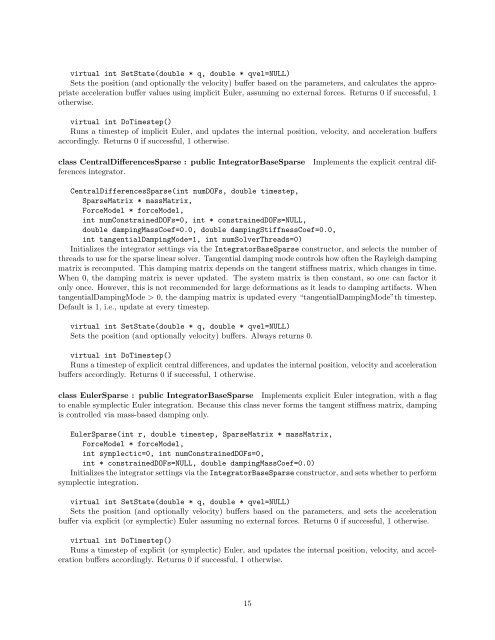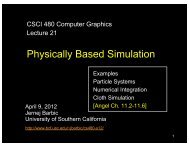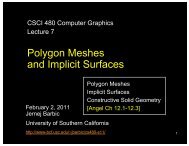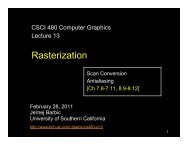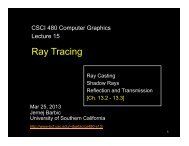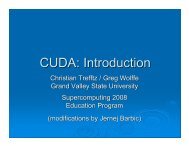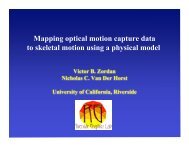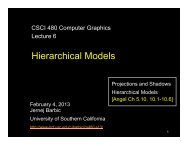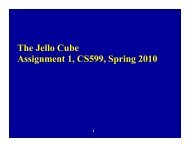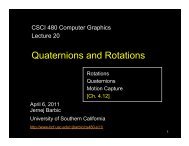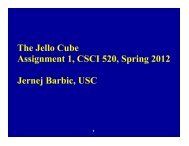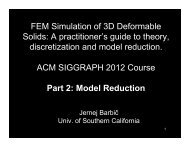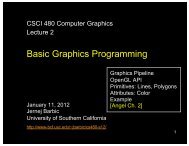Vega FEM Library (v1.1) User's Manual - University of Southern ...
Vega FEM Library (v1.1) User's Manual - University of Southern ...
Vega FEM Library (v1.1) User's Manual - University of Southern ...
You also want an ePaper? Increase the reach of your titles
YUMPU automatically turns print PDFs into web optimized ePapers that Google loves.
virtual int SetState(double * q, double * qvel=NULL)<br />
Sets the position (and optionally the velocity) buffer based on the parameters, and calculates the appropriate<br />
acceleration buffer values using implicit Euler, assuming no external forces. Returns 0 if successful, 1<br />
otherwise.<br />
virtual int DoTimestep()<br />
Runs a timestep <strong>of</strong> implicit Euler, and updates the internal position, velocity, and acceleration buffers<br />
accordingly. Returns 0 if successful, 1 otherwise.<br />
class CentralDifferencesSparse : public IntegratorBaseSparse Implements the explicit central differences<br />
integrator.<br />
CentralDifferencesSparse(int numDOFs, double timestep,<br />
SparseMatrix * massMatrix,<br />
ForceModel * forceModel,<br />
int numConstrainedDOFs=0, int * constrainedDOFs=NULL,<br />
double dampingMassCoef=0.0, double dampingStiffnessCoef=0.0,<br />
int tangentialDampingMode=1, int numSolverThreads=0)<br />
Initializes the integrator settings via the IntegratorBaseSparse constructor, and selects the number <strong>of</strong><br />
threads to use for the sparse linear solver. Tangential damping mode controls how <strong>of</strong>ten the Rayleigh damping<br />
matrix is recomputed. This damping matrix depends on the tangent stiffness matrix, which changes in time.<br />
When 0, the damping matrix is never updated. The system matrix is then constant, so one can factor it<br />
only once. However, this is not recommended for large deformations as it leads to damping artifacts. When<br />
tangentialDampingMode > 0, the damping matrix is updated every “tangentialDampingMode”th timestep.<br />
Default is 1, i.e., update at every timestep.<br />
virtual int SetState(double * q, double * qvel=NULL)<br />
Sets the position (and optionally velocity) buffers. Always returns 0.<br />
virtual int DoTimestep()<br />
Runs a timestep <strong>of</strong> explicit central differences, and updates the internal position, velocity and acceleration<br />
buffers accordingly. Returns 0 if successful, 1 otherwise.<br />
class EulerSparse : public IntegratorBaseSparse Implements explicit Euler integration, with a flag<br />
to enable symplectic Euler integration. Because this class never forms the tangent stiffness matrix, damping<br />
is controlled via mass-based damping only.<br />
EulerSparse(int r, double timestep, SparseMatrix * massMatrix,<br />
ForceModel * forceModel,<br />
int symplectic=0, int numConstrainedDOFs=0,<br />
int * constrainedDOFs=NULL, double dampingMassCoef=0.0)<br />
Initializes the integrator settings via the IntegratorBaseSparse constructor, and sets whether to perform<br />
symplectic integration.<br />
virtual int SetState(double * q, double * qvel=NULL)<br />
Sets the position (and optionally velocity) buffers based on the parameters, and sets the acceleration<br />
buffer via explicit (or symplectic) Euler assuming no external forces. Returns 0 if successful, 1 otherwise.<br />
virtual int DoTimestep()<br />
Runs a timestep <strong>of</strong> explicit (or symplectic) Euler, and updates the internal position, velocity, and acceleration<br />
buffers accordingly. Returns 0 if successful, 1 otherwise.<br />
15


